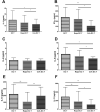Cyclosporine A, in Contrast to Rapamycin, Affects the Ability of Dendritic Cells to Induce Immune Tolerance Mechanisms
- PMID: 34632525
- PMCID: PMC8502748
- DOI: 10.1007/s00005-021-00632-7
Cyclosporine A, in Contrast to Rapamycin, Affects the Ability of Dendritic Cells to Induce Immune Tolerance Mechanisms
Abstract
Following organ transplantation, it is essential that immune tolerance is induced in the graft recipient to reduce the risk of rejection and avoid complications associated with the long-term use of immunosuppressive drugs. Immature dendritic cells (DCs) are considered to promote transplant tolerance and may minimize the risk of graft rejection. The aim of the study was to evaluate the effects of immunosuppressive agents: rapamycin (Rapa) and cyclosporine A (CsA) on generation of human tolerogenic DCs (tolDCs) and also to evaluate the ability of these cells to induce mechanisms of immune tolerance. tolDCs were generated in the environment of Rapa or CsA. Next, we evaluated the effects of these agents on surface phenotypes (CD11c, MHC II, CD40, CD80, CD83, CD86, CCR7, TLR2, TLR4), cytokine production (IL-4, IL-6, IL-10, IL-12p70, TGF-β), phagocytic capacity and resistant to lipopolysaccharide activation of these DCs. Moreover, we assessed ability of such tolDCs to induce T cell activation and apoptosis, Treg differentiation and production of Th1- and Th2-characteristic cytokine profile. Data obtained in this study demonstrate that rapamycin is effective at generating maturation-resistant tolDCs, however, does not change the ability of these cells to induce mechanisms of immune tolerance. In contrast, CsA affects the ability of these cells to induce mechanisms of immune tolerance, but is not efficient at generating maturation-resistant tolDCs.
Keywords: Cyclosporine A; Dendritic cells; Immune tolerance; Immunosuppressive agents; Rapamycin; T cells.
© 2021. The Author(s).
Conflict of interest statement
The authors declare no conflict of interest.
Figures








Similar articles
-
Rapamycin treated tol-dendritic cells derived from BM-MSCs reversed graft rejection in a rat liver transplantation model by inducing CD8+CD45RC-Treg.Mol Immunol. 2021 Sep;137:11-19. doi: 10.1016/j.molimm.2021.03.018. Epub 2021 Jun 26. Mol Immunol. 2021. PMID: 34182227
-
Modulatory effect of rapamycin and tacrolimus on monocyte-derived dendritic cells phenotype and function.Immunobiology. 2021 Jan;226(1):152031. doi: 10.1016/j.imbio.2020.152031. Epub 2020 Nov 23. Immunobiology. 2021. PMID: 33278711
-
[Rapamycin-conditioned dendritic cells induced immune tolerance through the regulation of Treg/Th17 cells in mice].Zhonghua Yi Xue Za Zhi. 2015 Aug 11;95(30):2469-73. Zhonghua Yi Xue Za Zhi. 2015. PMID: 26711212 Chinese.
-
Use of rapamycin in the induction of tolerogenic dendritic cells.Handb Exp Pharmacol. 2009;(188):215-32. doi: 10.1007/978-3-540-71029-5_10. Handb Exp Pharmacol. 2009. PMID: 19031028 Review.
-
Recent discoveries in dendritic cell tolerance-inducing pharmacological molecules.Int Immunopharmacol. 2020 Apr;81:106275. doi: 10.1016/j.intimp.2020.106275. Epub 2020 Feb 7. Int Immunopharmacol. 2020. PMID: 32044665 Review.
Cited by
-
Heterogeneity of adherent and non‑adherent JAWS II dendritic cells.Oncol Lett. 2023 Jan 25;25(3):93. doi: 10.3892/ol.2023.13680. eCollection 2023 Mar. Oncol Lett. 2023. PMID: 36817038 Free PMC article.
-
Sinomenine promotes differentiation of induced pluripotent stem cells into immature dendritic cells with high induction of immune tolerance.World J Stem Cells. 2022 Aug 26;14(8):599-615. doi: 10.4252/wjsc.v14.i8.599. World J Stem Cells. 2022. PMID: 36157915 Free PMC article.
-
Dendritic Cells: A Bridge between Tolerance Induction and Cancer Development in Transplantation Setting.Biomedicines. 2024 Jun 3;12(6):1240. doi: 10.3390/biomedicines12061240. Biomedicines. 2024. PMID: 38927447 Free PMC article. Review.
References
MeSH terms
Substances
Grants and funding
LinkOut - more resources
Full Text Sources
Research Materials

